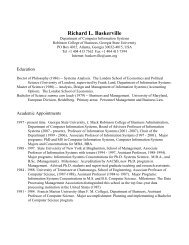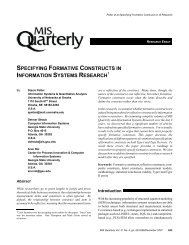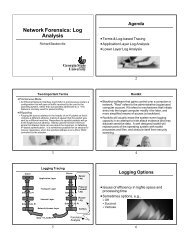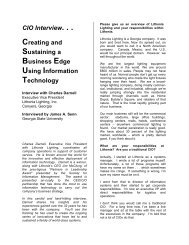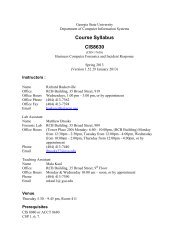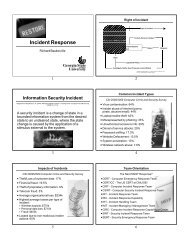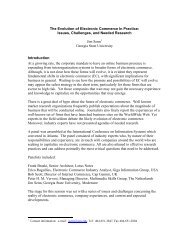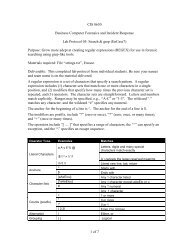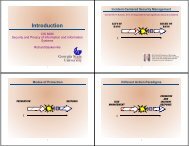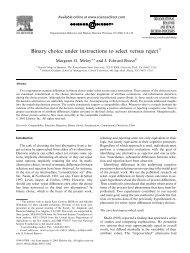The Relative Importance of Perceived Ease of Use in IS Adoption: A ...
The Relative Importance of Perceived Ease of Use in IS Adoption: A ...
The Relative Importance of Perceived Ease of Use in IS Adoption: A ...
Create successful ePaper yourself
Turn your PDF publications into a flip-book with our unique Google optimized e-Paper software.
Table 1. Summary <strong>of</strong> TAM Studies (1989-2000)StudyKarahanna et al. 1999(study 2)Venkatesh 1999SubjectsKnowledge workersKnowledge workerstak<strong>in</strong>g non-work relatedtra<strong>in</strong><strong>in</strong>g <strong>in</strong> eitherlecture-based tra<strong>in</strong><strong>in</strong>gor game-based tra<strong>in</strong><strong>in</strong>g<strong>Use</strong> Measure(TAM dependentvariable)Intended use <strong>of</strong> W<strong>in</strong>dowsamong actual usersIntended use <strong>of</strong> anInternet based applicationdeal<strong>in</strong>g with a virtualworkplace system (but notrelated to the knowledgeworkers’ actual workplace)Gefen 2000 Knowledge workers Intended adoption <strong>of</strong> anew ERPDid PEOUAffect<strong>Use</strong>?NoYesNo<strong>The</strong> role <strong>of</strong> PEOU, however, is likely to be more complex than that. PEOUmeasures user assessments <strong>of</strong> ease <strong>of</strong> use and ease <strong>of</strong> learn<strong>in</strong>g. PEOU, thus,deals with user motivation that is based on the assessment <strong>of</strong> the <strong>in</strong>tr<strong>in</strong>sic aspect<strong>of</strong> us<strong>in</strong>g the IT, such as its <strong>in</strong>terface and the process <strong>in</strong>volved <strong>in</strong> us<strong>in</strong>g it. Arguably,s<strong>in</strong>ce the extr<strong>in</strong>sic aspect <strong>of</strong> the IT (captured through PU) and not its <strong>in</strong>tr<strong>in</strong>sicaspect, <strong>in</strong> many cases, is the reason a new IT is adopted, this implies that PU andnot PEOU should directly affect IT adoption. Much <strong>of</strong> the TAM-related researchseems to support this conclusion (see Table 1).Nonetheless, by the same logic, PEOU should affect IT adoption when the<strong>in</strong>tr<strong>in</strong>sic characteristics <strong>of</strong> the IT, such as its <strong>in</strong>terface clarity and navigational ease,contribute to the value <strong>of</strong> the actual outcome for which the IT is be<strong>in</strong>g used.Conceptually, this should occur when the output <strong>of</strong> the IT is <strong>in</strong>extricably bound tothe <strong>in</strong>terface itself, <strong>in</strong> which case, the PEOU <strong>of</strong> the IT should correlate directly to thevalue placed on IT outcomes.Whether the motivation to use the new IT is <strong>in</strong>tr<strong>in</strong>sic or extr<strong>in</strong>sic dependsupon the nature <strong>of</strong> the task for which the new IT is be<strong>in</strong>g employed, not upon thenature <strong>of</strong> the technology. Thus, e-mail usage can be an <strong>in</strong>tr<strong>in</strong>sic task, for example,if the objective <strong>in</strong> us<strong>in</strong>g it is simply to <strong>in</strong>form, or an extr<strong>in</strong>sic task, if the objective isJournal <strong>of</strong> the Association for Information Systems 8



